Perennial shrub with white flowers. Description of perennial shrubs that bloom in summer
It happens that on the territory of a summer cottage or garden plot there are shaded places. And yet there are not so many well-lit places. The reasons for the fact that there are many shaded places on the site can be very different. So, for example, on it in in large numbers shrubs grow, as well as trees. They, of course, give delicious fruits and berries, but they take up a lot of space and cast a rather voluminous shadow. Therefore, the plants growing under them are almost completely devoid of sunlight. However, few summer residents do not want the whole country cottage area was beautiful and original. The way out of this situation is very simple. So, in shady places you just need to plant shade-loving shrubs perennial for the garden.
Shade-tolerant perennial shrubs are conditionally divided into 3 different groups, namely: berry, flowering, and decorative and deciduous. Each of these plants has both certain pluses and minuses. And there are also such types of shrubs that not only look very impressive, but also give useful, fragrant and incredibly tasty fruits. Experienced gardeners and summer residents categorically do not recommend buying planting material in spontaneous markets, as there is a high probability that it will be of very poor quality. It is best to purchase seedlings in special stores that have a good reputation. Among the various types of shrubs, the most popular and common can be distinguished.
shade tolerant flowering shrubs

Such a shrub has a very effective appearance, especially during the flowering period, when it is almost completely covered with inflorescences, consisting of flowers of a saturated color. Its leaf blades are fleshy. Rhododendron feels great in the shading created by tall trees and shrubs, in which many other plants can simply die.
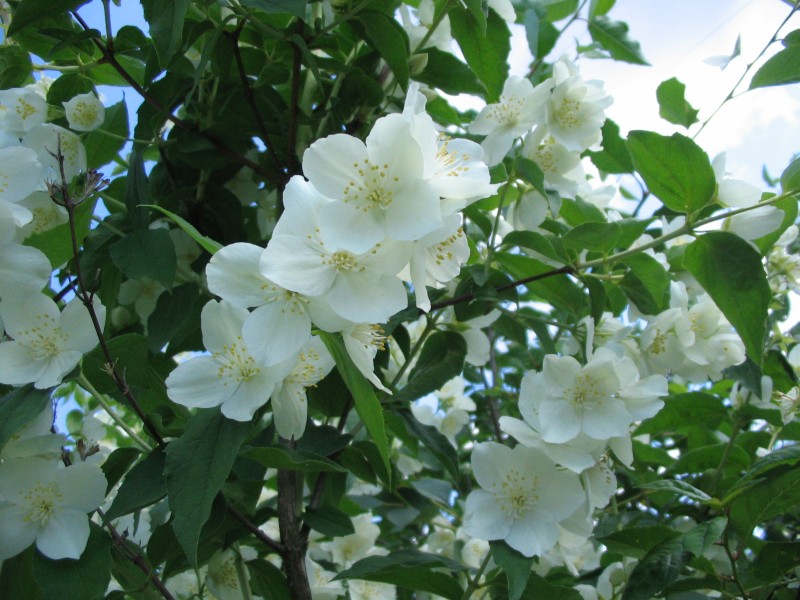
This shrub is very popular with gardeners and gardeners. Such a very beautiful plant will be an excellent decoration for almost any site. Jasmine looks especially impressive in the process of flowering. At this time, its branches are covered with snow-white lush inflorescences, from which a very pleasant and rather strong smell emanates. An important advantage of such a shrub is its undemanding to the place of growth, as well as to the quality of the soil. can adapt to absolutely any growing conditions. So, he perfectly withstands dry periods, and he is also not afraid of quite frosty winters. However, in order for your site to be decorated with a compact and neat bush, it will need to be cut systematically and often enough.
Shade tolerant berry bushes
Such perennials suitable for those gardeners and summer residents who want the plants grown by them to be not only very beautiful, but also bring certain benefits.

Such a shrub is quite popular in eastern countries. It is fast growing and frost resistant. It is quite easy to care for him, and he also tolerates a dry period perfectly. Such a shrub has small, very beautiful leaf plates, which in the fall change their green color to rich burgundy. The barberry grows berries with high palatability. They are used in cooking to prepare a variety of dishes.

It can grow in both sunny and shady places. And such a shrub needs to be watered quite rarely and moderately, while it can withstand a dry period. Very tasty berries grow on the plant, which are often used to make jam.
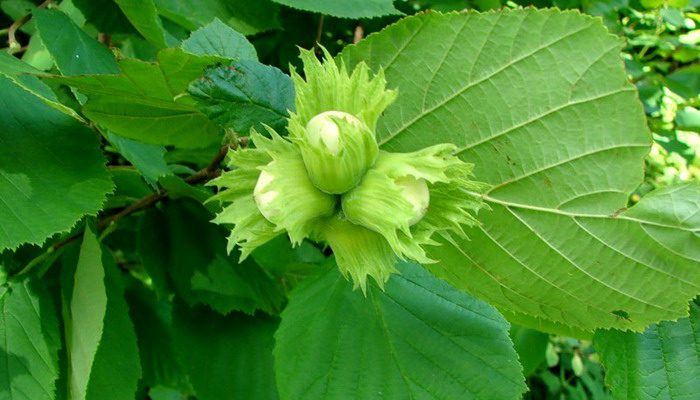
This plant prefers to grow only on non-acidic soil. If the soil is acidic, then it is recommended to add sand to it. Quite tasty nuts grow on hazel.
Shade-tolerant ornamental foliage plants
This group includes many plants. Here is some of them.

Such a plant has spectacular leaves of a rich lemon color. It can be planted both together with other shrubs, and singly. It is frost- and drought-resistant, and also unpretentious in care.

This shrub grows very quickly and does not need special care. AT winter time it also looks quite impressive. Leaves of saturated color will certainly bring zest and a peculiar charm to your garden.

Such evergreen shrub loves moisture. With systematic watering, it will become very lush and even be able to bloom.
Such shade-tolerant shrubs will be a wonderful decoration for any site.
Shrubs that bloom all summer, winter-hardy - very popular plants for garden plots. Their advantage is that they can please the eye all summer with their abundant bright flowering, and many more with a pleasant persistent aroma.
Figure 1. Spirea pleases the eye with its bright and lush flowers from May to October.
As a rule, many gardeners prefer perennial plants. This is not at all surprising, since such a shrub is winter-hardy, and this already indicates that there is no need to dig it out for the winter. It is these plants that are the best solution for zoning a garden or a whole summer cottage.
Varieties of winter-hardy shrubs
perennial flowering shrubs are the most popular. After all, they can not only not be dug up for the winter, but not even insulated. This is very important for regions with a harsh or temperate climate. Consider the most popular and beautiful shrubs, which can be grown on plots in almost any region.
Spirea, lilac, buddleia and hydrangea
 Spirea is considered a very beautiful ornamental shrub that can bloom from May to October. A feature is that this plant has very heavy clusters of small white or lilac flowers (Figure 1). Due to this structure, the bush always seems lush and looks very rich.
Spirea is considered a very beautiful ornamental shrub that can bloom from May to October. A feature is that this plant has very heavy clusters of small white or lilac flowers (Figure 1). Due to this structure, the bush always seems lush and looks very rich.
To date, breeders have already bred several varieties of this plant. There are those that bloom exclusively in the summer months, and there are those that only begin to bloom in the fall. Therefore, you can enjoy the beauty of the plant until the frost. Another feature of this species is the size. Regular varieties reach a height of 2.5 meters. Many gardeners even like it, as they have the opportunity to enclose an entire hedge with this plant. But if, nevertheless, the owners of the site want to see low lush bushes, then the spirea needs to be periodically sheared.
But there are also undersized varieties of spirea. The most popular variety is Golden Princess. This shrub reaches a maximum height of 70-75 cm. At the same time, it is quite lush in width, the flowers on it are somewhat larger than on all other tall varieties.
Another very famous and beautiful winter-hardy shrub is the common lilac. Everyone knows that lilac flowers have an exceptional aroma, and if you cut off flowering branches and put them in a vase at home, pour boiling water over them, they will last a very long time, delighting the household. But it should also be understood that lilacs usually grow very large and sprawling. And not all gardeners and summer residents are satisfied with this.
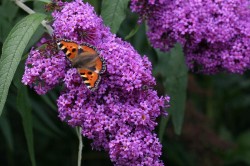
Figure 2. Buddley grows very actively in height, it needs to be trimmed regularly.
For this reason, the lilac should be cut periodically so that it does not grow so large. But this should be done preferably at regular intervals and very carefully so as not to spoil the plant. As for resistance to cold, there is no doubt that in a temperate climate, lilacs will feel good even in winter, and in spring they will give fresh buds. But if the climate is harsh, then it is better to give preference to winter-hardy varieties. These include Paul Tyrion and Alice Harding. This type of lilac is able to withstand even very severe frosts. At the same time, you can not wrap the bush in any way for the winter.
A plant very similar to spirea is buddleia. Even their flowers do not differ much (Figure 2). For regions with a temperate climate, buddley is an excellent option for decorating the site. But if the winter is expected to be harsh, then the plant is best before the onset of cold weather, when flowering is completed, how to spud and cover with a film or spruce branches.
Buddleya is a very tall plant. It can reach 3 meters in height. It can also and should be cut off periodically, but in most cases this does not greatly affect the growth of the plant. Therefore, buddleia is great for large areas where it is not supposed to grow undersized flowers and ornamental plants around it. Buddleia pruning is usually done in order to remove old dried inflorescences and allow new ones to develop normally.

Buddleia usually blooms from July to October. But, again, a lot here depends on how early the heat comes and the cold sets in. Depending on weather changes in summer and autumn, the flowering period of this plant may shift slightly.
Another chic shrub that tolerates winter well and blooms all summer is the hydrangea. This plant can be quite spreading, but not as tall as the plants listed above. It is distinguished by large inflorescences with very bright large flowers that immediately catch the eye.
This shrub requires pruning only twice a year - in spring and autumn, constantly needs a variety of top dressings, and also perfectly tolerates even very harsh winters without additional warming materials.
Hydrangea pruning is first done in the spring. During this period, the upper parts of all branches should be cut off to the topmost green bud, which has not yet blossomed. In autumn, absolutely all shoots that have not yet had time to become woody are removed from the plant. After all, over time, the plant gradually becomes like a small tree, as the stems become very powerful, hard, and turn brown.
Jasmine and Japanese quince
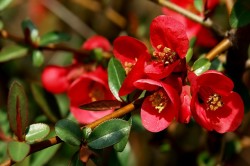
Figure 3. Japanese quince easily endures harsh winters and begins to bloom in early spring.
A beautiful shrub that blooms almost all summer and is most valued for its very delicate and pleasant aroma is jasmine (some also call it mock orange). For regions where winters are very cold, it is best to choose jasmine varieties such as Snowstorm or Zhemchug for planting. All other hybrids are no less beautiful, but they endure winter, if it is cold enough, somewhat worse. Although, with good wrapping, they do not freeze.
Jasmine usually blooms only in June and July, but at this time the bushes are so fragrant that you can stay near them for eternity. At the same time, the flowers are also very beautiful, they have White color and differ in the special tenderness of the petals. Summer residents often prefer to grow jasmine also because you can collect its flowers after flowering, dry them and then brew them to drink healthy and fragrant tea.
The original plant, originally from Japan, is the Japanese quince. Such a bush blooming in summer can be both tall and short. Therefore, here it is possible to choose for yourself the variety that will look best on the site.
Japanese quince is a very beautiful winter-hardy shrub that has bright red flowers, somewhat reminiscent of the color of a pomegranate (Figure 3). This plant usually begins to bloom in early spring or early summer, while the flowering period ends somewhere in mid-August. Quince does not need special care, despite the fact that the climate in the homeland of this plant is completely different. The older the plant, the more frost resistant it is.
There were cases when, in especially severe winters, the quince froze a little. But already with the onset of heat, the plant recovered very quickly and again produced green buds. This shrub is often planted in areas where the main thing is the decorative appearance of the territory, where special classics and elegance are important. And the bright flowers of this plant stand out perfectly against the background of fresh greenery and give the garden a special touch.
Features of care

But to know only the names and features of ornamental shrubs for the garden, which bloom all summer and are resistant to winter cold and frost, is very little. It is also necessary to take into account and follow the basic rules for caring for them. After all, even the most unpretentious plants can wither if caring for them is fundamentally wrong.
First of all, it is imperative to observe the periods of pruning shrubs. When purchasing a plant, you need to ask the sellers right away when it is better to start pruning and how to do it. If you neglect these tips, then the shrub will very quickly grow into an awkward tree that will no longer look so neat and beautiful. And this is absolutely not necessary for the owners of the site.
It is very important to consider what kind of soil a certain type of shrub needs. As a rule, some plants like loose, high-quality soil, where fertilizers and mineral supplements are constantly applied. Other bushes simply do not tolerate this.
They feel much better in the ground, which is hard, where there is practically nothing useful. Only then will they bloom in full force and smell fragrant.
It is also important to immediately find out during the acquisition of an ornamental plant whether it needs to be hilled or covered for the winter. Many winter-hardy shrubs tolerate winter well, do not freeze, but at the same time, if they are slightly covered before the onset of cold weather, they will bloom much more abundantly, and their first buds will bloom earlier. And such a plant will almost never get sick. There are few species of precisely winter-hardy shrubs that bloom all summer, which require hilling and shelter. Usually these are recently bred varieties that have not yet had time to adapt to the climate.
It should be clearly understood that before deciding to land on the site of one or another winter-hardy shrub, you should allocate enough space for it and make sure that an adult plant does not interfere with the development of other plants in the future. After all, all large bushes give a shadow, which does not always favorably affect other seedlings. Proper site planning, skillful zoning and taking into account the interaction of all plants during development are the main principles of successful gardening.
You can beautifully arrange a garden plot not only with the help of flower beds, but also perennial shrubs blooming in different periods from spring to autumn. Depending on the area of \u200b\u200bthe territory, you can choose miniature or sprawling forms. ornamental plants. An important role is played by the correct selection of shrubs, their combination with each other.
Ornamental shrubs have a special place in the territory country house, dachas. They are often used by landscape designers, bringing to life the wishes of the owners of the plots. In favor of choosing such a tool for decorating the landscape is the unpretentiousness of plants in caring for them, the variety of shrub forms and shades of flowering.
Ornamental perennial shrubs blooming in spring
After the monotonous winter picture of the garden, shrubs will revive it with delicate flowers, waking up first in nature:
- There are several types, or meadowsweet. The branches of the deciduous shrub bend beautifully, reaching a height of both fifteen centimeters and two and a half meters. The color of the small flowers of the plant is varied - from pale white to dark crimson. Spirea is used in group and single plantings. There are plant species that bloom in early spring and summer. The spring types include Argut spirea with snow-white fragrant flowers, Nipponskaya - with yellow-green corymbose inflorescences.
- In mid-May, the Vaterer bean tree blooms, the golden yellow flowers of which hang beautifully on half-meter inflorescences. The shrub is intended for large areas, as it increases in width by fifteen centimeters in a year, and in height - up to twenty-five. In regions with a cold climate, you can grow the anagiroleaf bean, the hanging shoots of which adorn the tassels of yellow flowers.
- A plant of the Heather family is the king of ornamental shrubs. Lush flowers collected in a brush adorn garden plots in late April - early May. Depending on the variety, the flowers have a pink hue (Daurian rhododendron), yellow, purple-violet (Canadian rhododendron), creamy white (short-fruited rhododendron). There are also species that shed their foliage, and some retain their greenery until the onset of winter. The plant blooms for up to thirty days. Many varieties of rhododendron endure frost.
- Decorative Japanese quince in flat rounded red flowers, ovate dark green leaves that change color to orange in autumn. Use a perennial shrub for single plantings. It tolerates frost, but is picky about soil and light.
- , or is distinguished by the sweet aroma of white flowers. Flowering shrub lasts about two weeks. There are both low-growing varieties of plants, and a height of one and a half to two meters.
- One of the first to bloom in spring, cultivars of which are unpretentious in cultivation. Hanging branches of the plant look great on the trellis. The plant is decorative both in flowers of various shades and in variegated leaves.
- Luxurious shrub with clusters of purple, white flowers has long firmly won its place on garden plots, in the yards. It does not require special care. The only thing is that it grows more magnificent after annual pruning. More than a hundred varieties of lilacs have been bred by breeders. They are good in the form of hedges, alleys, in decorative groups.
All types of perennials that bloom in spring can be used in garden design, and different varieties will help decorate both small areas and vast suburban areas.
Description of perennial shrubs that bloom in summer
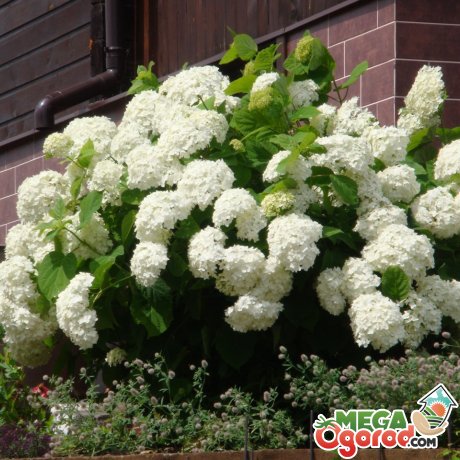
If groups of inflorescences appear on the young shoots of the current year, then such a spirea is classified as a summer species:
- From July to August, a shrub blooms with red-brown branches and lanceolate leaves seven centimeters long. Especially popular with a height of about two meters with spreading branches covered with panicles of bright pink inflorescences. Thanks to pruning, the trees delight with a powerful developed skeleton.
- distinguishes the ability to change the color of flowers during the summer. From snow-white, they can turn into pinkish, then burgundy. ornamental shrubs bloom profusely from June to late summer. They tolerate winter well, recovering even after freezing. Landscape designers appreciate the variety of plant forms, its generous flowering, which helps to plant shrubs in any area.
- Although it belongs to the species that are afraid of frost, the colorful flowering of the shrub attracts gardeners. Plant varieties are dwarf - up to a meter in height, and tall - up to three meters. Saturated colors of inflorescences from white to all shades of pink look great against the background of dark green weigela leaves. The plant bushes well after pruning, when young shoots are shortened by half. Perennial demanding on lighting, soil, temperature.
- In addition to the yellow flowers of caragana, the tree is famous for useful properties. An unpretentious tree is covered with fragrant flowers in early June. Collected in inflorescences, they look like bells with tiny teeth. Then small pods of beans appear in their place. Another name for the plant is yellow acacia. It easily tolerates both drought and cold, unpretentious care. The root of the plant is used in the treatment of sore throats, flu. The design uses caragana to strengthen the banks of the pond, slopes. Spectacular plant as a hedge, decoration of alleys. Acacia flowers are very fond of bees.
It is not easy to choose a flowering shrub for growing in the garden, first you need to think over a place for it, learn about the soil and temperature preferences of the future tenant of the site.
Types of perennial flowering shrubs for the autumn garden

Few types of shrubs bloom in autumn, the most interesting of them will become an echo of the outgoing bright summer:
- blooms not only in summer, but also in autumn. Covered with pale white, pink flowers, the branches radiate a pleasant smell until early October. Undersized varieties include golden heather, covered by autumn with brown foliage, purple flowers. In the Boskop variety, copper-red leaves appear on the branches in autumn, surrounded by pinkish inflorescences.
- From July to October, buddley bushes are covered with panicles of flowers. After the faded cluster, two new ones appear. Color shades range from pastels to vibrant yellows, purples, and oranges. They attract butterflies with their scent. It is best to grow shrubs in warm climates. But a good shelter saves him from frost, and after freezing, the shoots easily grow back.
- Shrub forms are known for their constant flowering until autumn. Flowers are the main decoration of the plant. Their diameter reaches thirteen centimeters, they differ in lemon, snow-white, scarlet colors. The trunk of the shrub is covered with bark, each variety has a different color. The plant is used as a flower bed decoration, in group plantings, near paths, as a hedge.
- Bushes can also bloom for a long time, decorating flower beds with hats of bright flowers.
Autumn flowering of perennial shrubs occurs when the weather favors their development, delighting with warm sunny days.

The correct arrangement of flowering shrubs will help change the image of the site, make it beautiful:
- Mixing styles always makes the landscape original. Flowering shrubs along the paths will look solemn, and a composition of lilacs surrounded by daisies or sunflowers will soften the severity of the garden, bringing it closer to simplicity, the village.
- Viewpoints play an important role. The brightness of the inflorescences is best observed at some distance, and the pale tones - close. Shrubs with small flowers should be in the foreground of the garden, with large flowers behind.
- The color scheme is also important for design quests. If you want the predominance of one color, then bushes with one main one, for example, pink, are taken as the basis, placing shades of tone next to it. A combination of colors such as blue and blue, or yellow, orange, red look harmonious. In such areas, there is an ease of perception of the landscape, there is more room for creativity. Such shades of flowering shrubs as red and green, blue and orange, yellow and purple complement each other. It is important to find such a color of the site so that it is not intrusive and flashy. Everything needs a measure.
- Different periods of flowering shrubs are used to ensure that there are no empty places on the territory. If spring-flowering trees are located next to summer or autumn species, then they can decorate group plantings with dark green or yellow leaves.
- Flowering perennial shrubs are spectacular against the background of conifers. Their low-growing species are combined with flowering plants in flower beds. Tree-like species are often used as hedges, islands in the middle of the green velvet of lawns.
Creative ideas for the use of shrub flowering plants in the landscape of the dacha territory are diverse, everyone can embody them.
More information can be found in the video:



